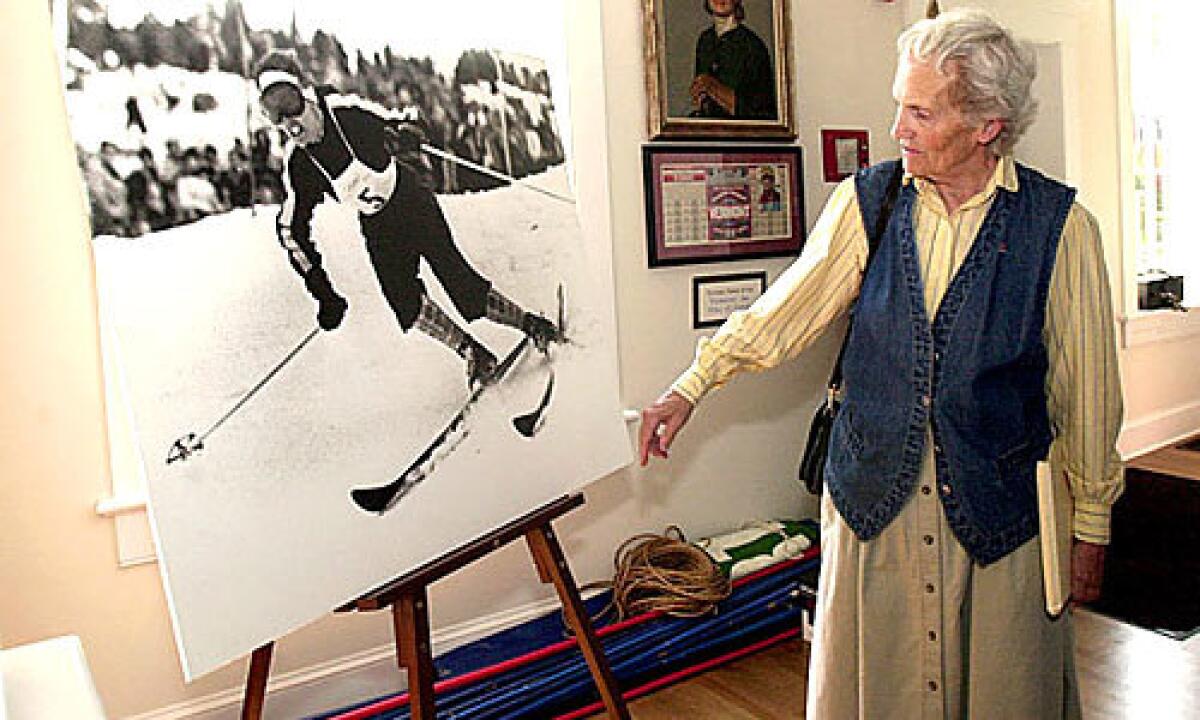Andrea Mead Lawrence dies at 76; Olympic Alpine skier became environmentalist

- Share via
Andrea Mead Lawrence, who was the only American alpine skier to win two gold medals in a single Olympics and went on to become a leading conservationist in the Eastern Sierra, has died. She was 76.
Lawrence, who spent four decades working to preserve the mountainous region and founded several environmental organizations, died Monday at her Mammoth Lakes home of the cancer she had been diagnosed with in 2000, her son Matthew said.
She was a 19-year-old sensation coming off a dream year -- winning a dozen international races and appearing on the cover of Time magazine -- when she arrived at the 1952 Winter Games in Oslo. After taking the giant slalom, she captured a second gold, in the slalom, after falling on the first of two runs.
She often recalled that during her final slalom run, she had an amazing sense of clarity and purpose that allowed her to go “like a bullet down the course.”
The accomplishment “helped lay the groundwork for the rest of my life,” she told The Times in 2004.
A three-time Olympian, Lawrence had been named to the 1948 Olympic team at 14 and competed in the 1956 Games after having three children. Yet she refused to allow her experience as a top Olympic athlete to define her.
“I’ve never wanted celebrity status unless it furthers the things I’m involved in and have a passion for,” Lawrence told the Oakland Tribune in 2002. “It’s not about how many medals you’ve won, but what you do with them.”
She did not display her medals but kept them in a box.
In 1998, Lawrence told Olympic historian David Wallechinsky that she had asked herself: “What if I could take the same sort of striving for high-quality perfection that I did with my skiing and apply it to something good, something relevant to life?”
“That’s how she became an environmentalist,” Wallechinsky recalled on Tuesday.
After moving from Malibu to Mammoth Lakes in 1968, the newly divorced mother of five began transforming herself into an environmental activist.
Local business leaders soon asked her to spearhead the battle against construction of eight-story condominiums in Mammoth. Her group, the Friends of Mammoth, halted the project in a case that reached the state Supreme Court. That ruling laid the foundation for citizen enforcement of the California Environmental Quality Act, said Antonio Rossmann, a lawyer who represented Inyo County in water campaigns.
“Andrea in her lifetime was the most significant and effective citizen activist in California,” Rossmann said.
Among several conservation groups Lawrence helped found was the Sierra Nevada Alliance, a regional environmental protection coalition. A few years ago, she established the nonprofit Andrea Lawrence Institute for Mountains and Rivers to work for a balance between economic growth and preservation of the region’s natural beauty.
Elected in 1982, Lawrence spent 16 years as a member of the Mono County Board of Supervisors, battling unchecked development and testifying before Congress for environmental causes. She campaigned for the passage of several wilderness bills and successfully championed the Bodie Protection Act of 1993, which saved the California mining town from development.
Bud Greenspan, an Olympic historian and documentarian, used a formula that took into account post-Olympic accomplishments when he put Lawrence atop his 2002 list of greatest winter Olympians of all time.
“Andrea personified the Greek concept of the Ideal Athlete . . . excellence both in body and mind,” Greenspan told The Times in an e-mail. “It is indeed rare to find someone who throughout her life pursued two passions in the purest and highest form of the human spirit.”
She was born April 19, 1932, in Rutland, Vt., one of two children of Bradford and Janet Mead, who founded Vermont’s Pico Peak ski resort.
By 6, she was absorbing the lessons that the resort’s Swiss ski pro gave others. At 10, she took a run down a ski course in Lake Placid, N.Y., and had an epiphany during a hairpin turn.
“It was so natural, it was like a psychic click. . . . I knew instinctively that’s what I was meant to do,” Lawrence recalled earlier this year on Vermont Public Radio.
That same year, her father died in a boating accident, and she later recalled feeling pressured to grow up.
At the 1948 Olympics in Switzerland, she met David Lawrence, a member of the U.S. men’s ski team. They married in 1951.
Four months before the 1956 Games, she had her third child but again made the team. Competing in the giant slalom in Cortina d’Ampezzo, Italy, she tied for fourth place.
Upon settling in Aspen, Colo., Lawrence joined a local planning commission and realized that she had a passion for politics.
As a recreational skier, she refused to use ski poles, calling them “a crutch.”
“Even in her 60s, she was such a good skier,” said Chris Plakos, a longtime friend. “We used to compare her skiing to watching a sea gull in flight.”
Lawrence is survived by sons Cortlandt and Matthew; daughters Deirdre, Leslie and Quentin; brother Peter Mead; and four grandchildren.
Plans are being made for a public memorial.
More to Read
Start your day right
Sign up for Essential California for the L.A. Times biggest news, features and recommendations in your inbox six days a week.
You may occasionally receive promotional content from the Los Angeles Times.







